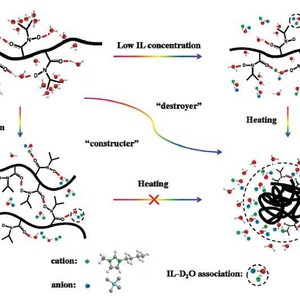The Influence of Ionic Liquid on Phase Separation of Poly(N-isopropylacrylamide) Aqueous Solution
Abstract
The role of ionic liquid, 1-butyl-3-methylimidazolium tetrafluoroborate ([Bmim][BF4]), on the phase transition behavior of concentrated PNIPAM solutions was investigated by FTIR spectroscopy in combination with two-dimensional correlation spectroscopy (2Dcos) and the perturbation correlation moving window (PCMW) technique for the first time. At low IL concentrations, the Tp of the PNIPAM solution decreases with increases in the IL concentration, due to the destabilization of the hydrated macromolecule structure via preferential interactions between IL and water molecules. However, at higher IL concentrations, unexpectedly, the phase transition behavior disappears. This has been attributed to the formation of a stable interaction network via intra- and intermolecular hydrogen bonding. Furthermore, two changes can be observed in the ν(C–H) region for the sample with 0.4 mol L−1 [Bmim][BF4]. The first change is related to the phase separation of the PNIPAM solution, while the second step is attributed to an IL–D2O association, which takes part in the globule construction, probably interacting with hydrophilic groups of PNIPAM. Thus, the role of ILs on the phase behavior of PNIPAM is embodied in two opposite aspects, the “destroyer” and the “constructer”.

<<全文链接>>

